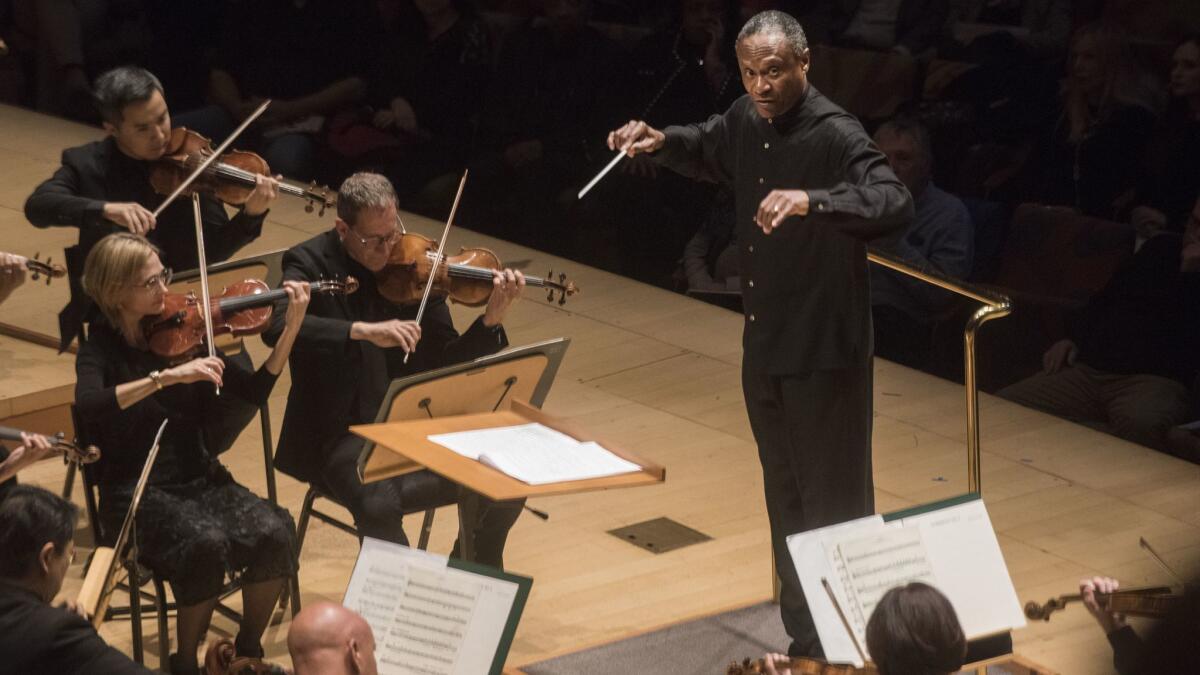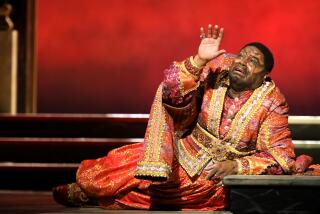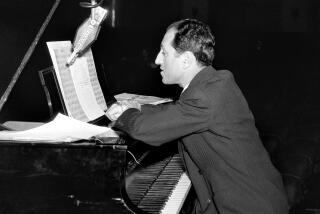Review: L.A. Phil revives the neglected ‘dean of African American composers’

When and why did the “dean of African American composers,” an iconic figure in American music and African American culture, go out of fashion? The when is far easier to answer than the why, especially after hearing the Los Angeles Philharmonic’s compelling programs Saturday and Sunday at Walt Disney Concert Hall called “William Grant Still & the Harlem Renaissance.”
The program notes claimed that Still’s “Afro-American” Symphony is “one of the most popular American symphonies of all time,” but it sure was a lot more popular in the 1930s and 1940s than today. Premiered in 1931 by the Rochester Symphony and the first symphony to incorporate blues with orchestral music so thoroughly and skillfully, the “Afro-American” was a sensation. The L.A. Phil didn’t get around to it until 1940, and was late in the game, any number of other major orchestras having already programmed it. Leopold Stokowski, a huge Still champion, took the symphony on tour with the Philadelphia Orchestra in 1936, including to L.A. Times critic Isabell Morse Jones noted that Still’s blues “are soft, insinuating blues which came from the South, not Gershwin’s Broadway.”
That is one great glory of Still. There are others from a composer who wrote five symphonies, eight operas, a couple of ballets and scores of chamber music songs and orchestral pieces that range from highly abstract and modernist to populist. Ultimately integrating African American culture into broader classical musical culture became Still’s mission.
Born in Mississippi in 1895 and Oberlin-trained, he played in jazz bands and in symphony orchestras and studied in New York with Edgard Varèse. At the time the most futurist composer in America, Varèse somewhat condescendingly encouraged Still to be himself, exploit his spectacular gift for melody and his blackness.
But as part of the Harlem Renaissance, Still had difficulty fitting in. His idea of an African American and classical music fusion could be so subtle that what appears obvious and maybe passes you over the first or second listen becomes resonant and apparent by the third.
He could be too black for the racist elements in the traditional classical music world and not black enough for the Harlem Renaissance. With his new-found success from the “Afro-American” Symphony and a Guggenheim Fellowship in 1934, he became a Harlem Renaissance expat and moved to L.A., where he found a mostly welcoming atmosphere.
His works were hugely popular at the Hollywood Bowl. Otto Klemperer admired his music and programmed it with the L.A. Phil. When George Szell came to town, he didn’t make a beeline to Stravinsky or Schoenberg but to South Central to visit with Still.
So what happened? Why are his works, many of which deal with themes still current and have their subject matter, like his opera “Highway 1, U.S.A.,” set right here, utterly neglected? The only time I ever encountered a Still opera (three of them have yet to be produced) was a student production while he was alive, and he died in 1978.
It may be that in the 1950s and 1960s, Still was a voice of reason at a time when reason didn’t seem to be doing enough toward getting equality and when radical styles of music seemed necessary for radical progress. “I don’t worry about being out of fashion,” he told The Times in 1970, when he turned 75. “Everybody has to be true to himself.
“I’m content.”
I’m not, and conductor Thomas Wilkins demonstrated why in both the “Afro-American” and Still’s Fourth Symphony, which was written in L.A. in 1944 but never before performed by the L.A. Phil. The Fourth has the fabulous and meaningful title “Autochthonous,” a synonym for indigenous. It treats African American musical elements not as symphonic color but as its essence. Sad and sweet, depression and uplift are its moods. The smooth flow is deceptive. Still skates over nothing, but his perspective is broad, not momentary. The Finale is so heart-wrenchingly beautiful that I wish Wilikins had repeated it. Who knows when we’ll hear it again?
Wilkins, the principal conductor of the Hollywood Bowl Orchestra, was making a rare and welcome appearance leading the L.A. Phil at Disney in a program that was more puzzling on paper than in performance. There was Duke Ellington — the tone poem “Harlem” and “Come Sunday” (with a recitation by actress Charlotte Blake Alston) on Saturday and “Three Black Kings” on Sunday — demonstrating the L.A. Phil’s capacity to cook, but also a strong contrast with Still.
There was also Gershwin’s “Rhapsody in Blue” and “Second Rhapsody.” On Saturday and Sunday, respectively. But here, whatever blues Gershwin got from Broadway were given the real thing by Aaron Diehl, who added considerably improvised embellishment to the piano solos. He is a young player with a touch as staccato as if he were playing a Scarlatti sonata and a nearly Baroque contrapuntal way of improvising, yet he bends pitches. That’s physically impossible, but he makes you believe your ears.
Finally, Wilkins gave the premiere of Adolphus Hailstork’s “Still Holding On,” another of the L.A. Phil centennial commissions. Dubbed by Wilkins the dean of today’s African American composers, Hailstork is another inexplicably neglected African American composer. Maybe it’s not inexplicable, because the 78-year-old extends the tradition of Still. The first movement of a symphony-in-progress, the 15-minute score applies themes from the “Afro-American” Symphony in a more contemporary harmonic language and in bolder orchestral colors.
An exquisite duet between oboe and cello, instruments that Still played, represents a love song between Still and his wife. Hailstork’s is a knowing tribute to the best unknown known American composer, one it’s time already we actually get to know. America’s operas companies, in particular, that means you.
More to Read
The biggest entertainment stories
Get our big stories about Hollywood, film, television, music, arts, culture and more right in your inbox as soon as they publish.
You may occasionally receive promotional content from the Los Angeles Times.
![LOS ANGELES, CA - JUNE 17: [Cody Ma and Misha Sesar share a few dishes from their Persian Restaurant Azizam] on Monday, June 17, 2024 in Los Angeles, CA. (Ethan Benavidez / For The Times)](https://ca-times.brightspotcdn.com/dims4/default/7ffc7f6/2147483647/strip/true/crop/5110x3417+306+0/resize/320x214!/quality/75/?url=https%3A%2F%2Fcalifornia-times-brightspot.s3.amazonaws.com%2F79%2Fdc%2F4d29255545f5b9813315901692bc%2F1459972-fo-azizam-review20-eba.JPG)






